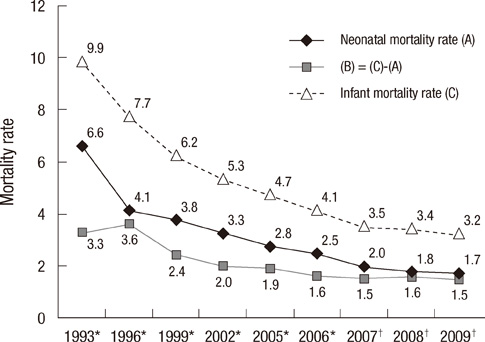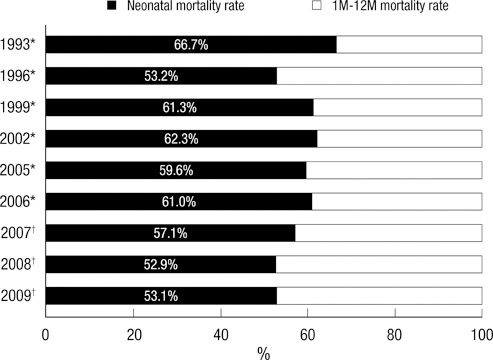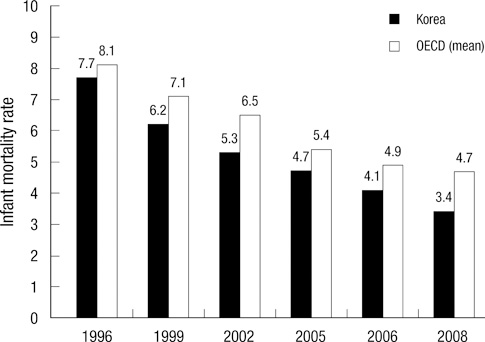J Korean Med Sci.
2011 Sep;26(9):1115-1123. 10.3346/jkms.2011.26.9.1115.
Decreasing Trends of Neonatal and Infant Mortality Rates in Korea: Compared with Japan, USA, and OECD Nations
- Affiliations
-
- 1Department of Pediatrics, Kyung Hee University School of Medicine, Seoul, Korea. baecw@khnmc.or.kr
- 2Department of Pediatrics, Kyung Hee University Graduate School and Department of Neonatology, Asan Medical Center, University of Ulsan College of Medicine, Seoul, Korea.
- KMID: 1779382
- DOI: http://doi.org/10.3346/jkms.2011.26.9.1115
Abstract
- Neonatal mortality rate (NMR) and infant mortality rate (IMR) are two of the most important indices reflecting the level of public health of a country. In this review, we investigated changes in NMR and IMR in Korea and compared the results with those of Japan, USA, and OECD nations. During the past 20 yr, NMR and IMR have lowered remarkably from 6.6 and 9.9 in 1993 to 1.7 and 3.2 in 2009, respectively, in Korea. It is an impressive finding that Korean IMR (3.2 in 2009) is lower than the average of OECD nations (4.7 in 2008), and USA (6.3 in 2009), although higher than Japanese IMR (2.8 in 2009). The proportion of NMR among the IMR calculation decreased from 66.7% in 1993 to 53.1% in 2009. The reason the value of Korea was higher than Japan but lower than USA was speculated to be an aspect of the health care service system. Several suggestions in perinatal, neonatal and infantile health care such as establishment of perinatal care center, research network system, regionalization, and new policies for care of pre-term and high risk pregnancy, are elucidated to achieve further improvement on NMR and IMR in Korea.
Keyword
MeSH Terms
Figure
Cited by 4 articles
-
The history of neonatology in Korea
Chong-Woo Bae
J Korean Med Assoc. 2016;59(7):490-497. doi: 10.5124/jkma.2016.59.7.490.Changes in neonatal outcomes in Korea
So Young Kim
J Korean Med Assoc. 2016;59(7):498-505. doi: 10.5124/jkma.2016.59.7.498.High Proportion of Nervous System Disease among Major Cause of Under-Five Death in Korea; Compared with OECD 14 Nations (2005-2010)
Hyun Seok Seo, Seok Won Choi, Ji Sung Kim, Jae Yong Choi, Cheol Am Kim, Byeong Hee Son, Kyun Woo Lee, Kwang Wook Koh
Kosin Med J. 2014;29(1):37-45. doi: 10.7180/kmj.2014.29.1.37.Regional Disparities in the Infant Mortality Rate in Korea Between 2001 and 2021
Hyeongtaek Woo, Ji Sook Kim
J Korean Med Sci. 2023;38(44):e367. doi: 10.3346/jkms.2023.38.e367.
Reference
-
1. Park CB, Park BT. Infant mortality rate: survey of recent fertility in Korea. 1981. Seoul: Korea Institute for Health and Social Affairs;11–25.2. Han YJ, Doh SR, Seo K, Park JH, Lee SU. Infant mortality level and characteristics in 1996. 1998. Seoul: Korea Institute for Health and Social Affairs, Korea Ministry of Health and Welfare;62–64.3. Korea Ministry of Health and Welfare. Infant mortality survey report in 1996. 1999. Seoul: Korea Ministry of Health and Welfare;31–33.4. Han SH, Kim IS. Recent trends of infant death rates and its determinants in Korea. Korean J Epidemiol. 1990. 12:57–89.5. UN, UN data, Infant mortality rate. accessed on 15 July 2011. Available at http://data.un.org/Data.aspx?q=infant+mortality&d=PopDiv&f=variableID%3a77.6. Han YJ, Doh SR, Lee SU, Lee HB, Lee MI. Infant mortality survey report in 1993. 1997. Seoul: Korea Ministry of Health and Welfare, Korea Institute for Health and Social Affairs;59–60.7. Han YJ, Doh SR, Lee SU, Lee HB, Lee MI. Infant mortality level and characteristics. 1996. Seoul: Korea Institute for Health and Social Affairs;70–74.8. Han YJ, Lee SU, Chang YS, Kim DJ, Lee SU. Infant mortality level and characteristics of perinatal death in 1999. 2002. Seoul: Korea Institute for Health and Social Affairs;39–43.9. Han YJ, Seo K, Lee SU, Lee SU, Shin CW. Infant and maternal death survey report in 2002-2003. 2005. Seoul: Korea Institute for Health and Social Affairs, Korea Ministry of Health and Welfare;67–70.10. Han YJ, Choi JS, Seo K, Lee SU, Oh HC, Kim NO, Hong JS, Shin SM, Lee NH. Infant and maternal death survey report in 2005-2006. 2008. Seoul: Korea Institute for Health and Social Affairs, Korean Medical Record Association, Korea Ministry of Health and Welfare;77–92.11. Korea Ministry of Health and Welfare. Infant mortality survey report in 1996. 1999. Seoul: Korea Ministry of Health and Welfare;33–37.12. Korea Ministry of Health and Welfare. Infant mortality survey report in 1999. Korea Ministry of Health and Welfare 1999 (Infant mortality level and characteristics of perinatal death in 1999). 2002. Seoul: Korea Ministry of Health and Welfare;39–43.13. Choi JS, Seo K, Lee NH, Lee SU, Shin CW, Bu YK. Infant and maternal death survey report in 2007-2008. 2010. Seoul: Korea Institute for Health and Social Affairs, Korean Medical Record Association, Korea Ministry of Health and Welfare;89–90.14. Korea Ministry of Health and Welfare. Yearbook of heath, welfare and family statistics in 2007. 2007. Seoul: Korea Ministry of Health and Welfare;56.15. Korea Ministry of Health and Welfare. Yearbook of heath, welfare and family statistics. 2009. Seoul: Korea Ministry of Health and Welfare in 2009;20.16. Statistical report of causes of death in Korea in 2009. Statistics Korea. accessed on 15 July 2011. Available at http://kostat.go.kr/wnsearch/search.jsp.17. Korea Ministry of Health and Welfare. OECD statistics in 2009. 2009. Seoul: Korea Ministry of Health and Welfare;96.18. OECD Health Data 2010, Infant mortality. OECD. accessed on 15 July 2011. Available at http://www.oecd.org/document/0,3746,en_2649_201185_46462759_1_1_1_1,00.html and http://www.oecd.org/dataoecd/4/36/46796773.pdf.19. Health statistics and health information systems, infant mortality. WHO. accessed on 15 July 2011. Available at http://www.who.int/healthinfo/morttables/en/index.html.20. WHO mortality database, infant death. WHO. accessed on 15 July 2011. Available at http://apps.who.int/whosis/database/mort/table2.cfm.21. Statistics, infant mortality rate. Japan Ministry of Health, Labour and Welfare. accessed on 15 July 2011. Available at http://www.mhlw.go.jp/english/database/db-hw/report/3.html.22. United States infant mortality rate. Index Mundi. Index Mundi. accessed on 15 July 2011. Available at http://www.indexmundi.com/united_states/infant_mortality_rate.html.23. Ministry of Health and Welfare. Health care and service for newborn, infant and mother: 2011. 2011. Seoul: Ministry of Health and Welfare;3–9.24. Change of statistical method for infant and mother's death survey in Korea. Statistics Korea. accessed on 15 July 2011. Available at http://kostat.go.kr/wnsearch/search.jsp.25. Hahn WH, Chang JY, Chang YS, Shim KS, Bae CW. Recent trends in neonatal mortality in very low birth weight Korean infants: in comparison with Japan and the USA. J Korean Med Sci. 2011. 26:467–473.26. Hwang NM. Health care and service system for newborn and infant in other nations. Proceeding of the 57th annual spring meeting of the Korean pediatric Society. 2007. 19: 27.27. Neonatal Research Network, Japan. accessed on 15 July 2011. Available at http://nrn.shiga-med.ac.jp/.28. Perinatal Care Center Network, Japan. accessed on 15 July 2011. Available at http://plaza.umin.ac.jp/nrndata/syukei.htm.29. Kusuda S, Fujimura M, Sakuma I, Aotani H, Kabe K, Itani Y, Ichiba H, Matsunami K, Nishida H. Morbidity and mortality of infants with very low birth weight in Japan: center variation. Pediatrics. 2006. 118:e1130–e1138.30. Itabashi K, Horiuchi T, Kusuda S, Kabe K, Itani Y, Nakamura T, Fujimura M, Matsuo M. Mortality rates for extremely low birth weight infants born in Japan in 2005. Pediatrics. 2009. 123:445–450.31. Bae CW. Bench-marking of Japanese perinatal center system for improving maternal and neonatal outcome in Korea. Korean J Perinatol. 2010. 21:129–139.32. National Institute of Child Health and Human Development (NICHD) Neonatal Research Network. accessed on June 2011. Available at https://neonatal.rti.org/.33. Vermont Oxford Network. accessed on June 2011. Available at http://www.vtoxford.org/.34. Payne NR, Finkelstein MJ, Liu M, Kaempf JW, Sharek PJ, Olsen S. NICU practices and outcomes associated with 9 years of quality improvement collaboratives. Pediatrics. 2010. 125:437–446.35. Fanaroff AA, Stoll BJ, Wright LL, Carlo WA, Ehrenkranz RA, Stark AR, Bauer CR, Donovan EF, Korones SB, Laptook AR, Lemons JA, Oh W, Papile LA, Shankaran S, Stevenson DK, Tyson JE. Trends in neonatal morbidity and mortality for very low birthweight infants. Am J Obstet Gynecol. 2007. 196:147.36. Stoll BJ, Hansen NI, Bell EF, Shankaran S, Laptook AR, Walsh MC, Hale EC, Newman NS, Schibler K, Carlo WA, Kennedy KA, Poindexter BB, Finer NN, Ehrenkranz RA, Duara S, Sánchez PJ, O'Shea TM, Goldberg RN, Van Meurs KP, Faix RG, Phelps DL, Frantz ID 3rd, Watterberg KL, Saha S, Das A, Higgins RD. Neonatal outcomes of extremely preterm infants from the NICHD Neonatal Research Network. Pediatrics. 2010. 126:443–456.37. Mathews TJ, Miniño AM, Osterman MJ, Strobino DM, Guyer B. Annual summary of vital statistics: 2008. Pediatrics. 2011. 127:146–157.38. MacDorman MF, Mathews TJ. Recent trends in infant mortality in the United States. NCHS Data Brief. 2008. (9):1–8.39. Mathews TJ, MacDorman MF. Division of Vital Statistics. Infant mortality statistics from the 2007 period linked birth/infant death data set. Natl Vital Stat Rep. 2011. 59:1–47.40. Anderson GF, Squires DA. Measuring the U.S. health care system: a crossnational comparison. Issue Brief (Commonw Fund). 2010. 90:1–10.41. Cohen RA, Martinez ME. Health insurance coverage: early release of estimates from the National Health Interview Survey. National Center for Health Statistics. accessed on 15 July 2011. Available at http://www.cdc.gov/nchs/nhis.htm.42. The Children's Health Insurance Program (CHIP). Children's Health Insurance Program Reauthorization Act of 2009 (CHIPRA or Public Law 111-3). accessed on 15 July 2011. Available at https://www.cms.gov/chipra/.43. Birth statistics in Korea in 2010. Statistics Korea. accessed on 15 July 2011. Available at http://kostat.go.kr/wnsearch/search.jsp.44. Moon JY, Hahn WH, Shim KS, Chang JY, Bae CW. Changes of maternal age distribution in live births and incidence of low birth weight infants in advanced maternal age group in Korea. Korean J Perinatol. 2011. 22:30–36.45. Choi SH, Park YS, Shim KS, Choi YS, Chang JY, Hahn WH, Bae CW. Recent trends in the incidence of multiple births and its consequences on perinatal problems in Korea. J Korean Med Sci. 2010. 25:1191–1196.46. Park YS, Choi SH, Shim KS, Chang JY, Hahn WH, Choi YS, Bae CW. Multiple births conceived by assisted reproductive technology in Korea. Korean J Pediatr. 2010. 53:880–885.47. Kim HY, Sun BY, Kim EY, Jung JH. Unwed mother's life world and policy agenda. 2009. Korean Women's Development Institute;39–40.
- Full Text Links
- Actions
-
Cited
- CITED
-
- Close
- Share
- Similar articles
-
- Decreasing Pattern in Perinatal Mortality Rates in Korea: In Comparison with OECD Nations
- Changes in Neonatal and Perinatal Vital Statistics during Last 5 Decades in Republic of Korea: Compared with OECD Nations
- Changes in Statistics of Maternal Death in Korea (1995-2010)
- Recent Trends in Neonatal Mortality in Very Low Birth Weight Korean Infants: In Comparison with Japan and the USA
- The Changes in the Birth and Mortality Rates of Newborn in Korea








